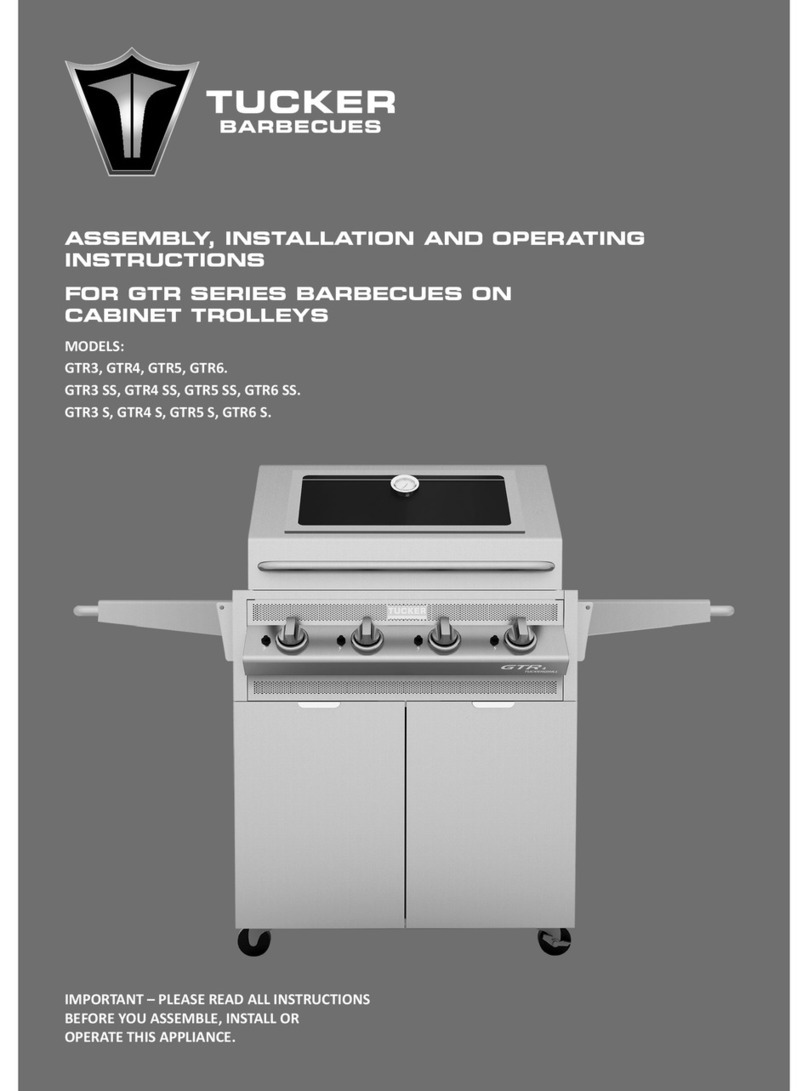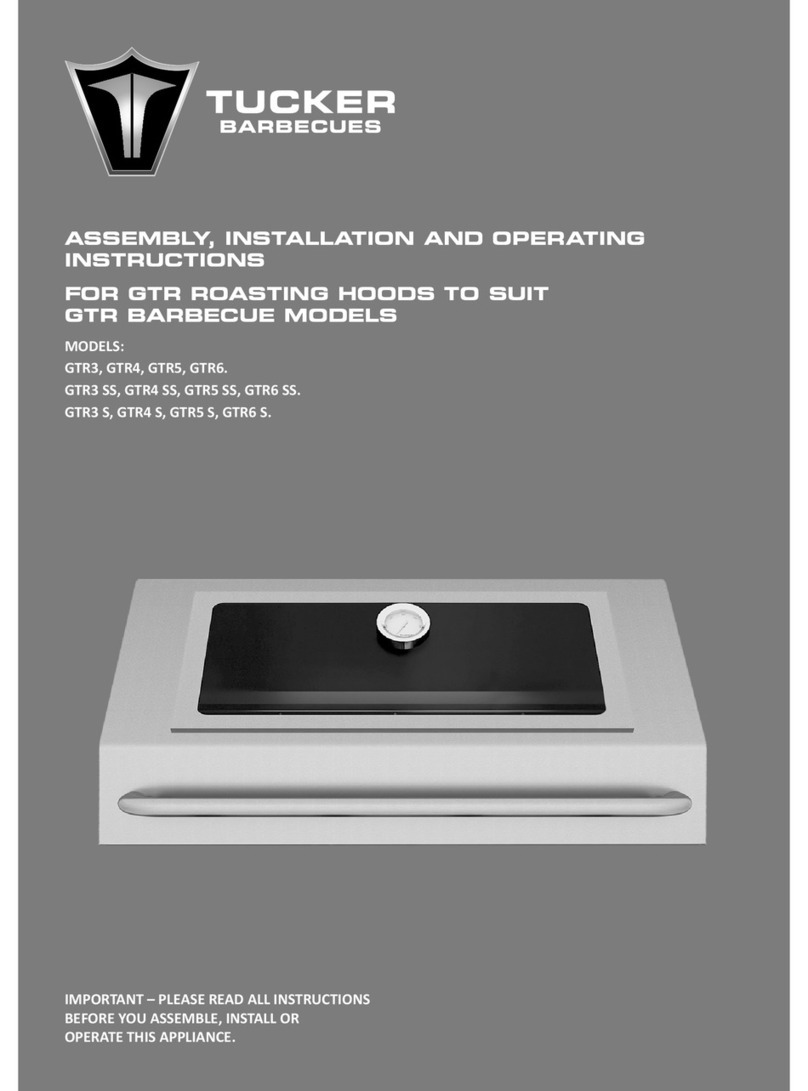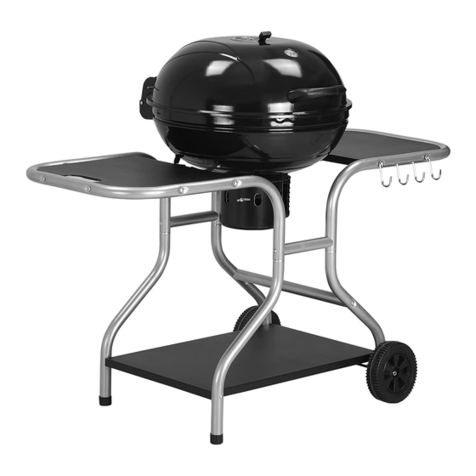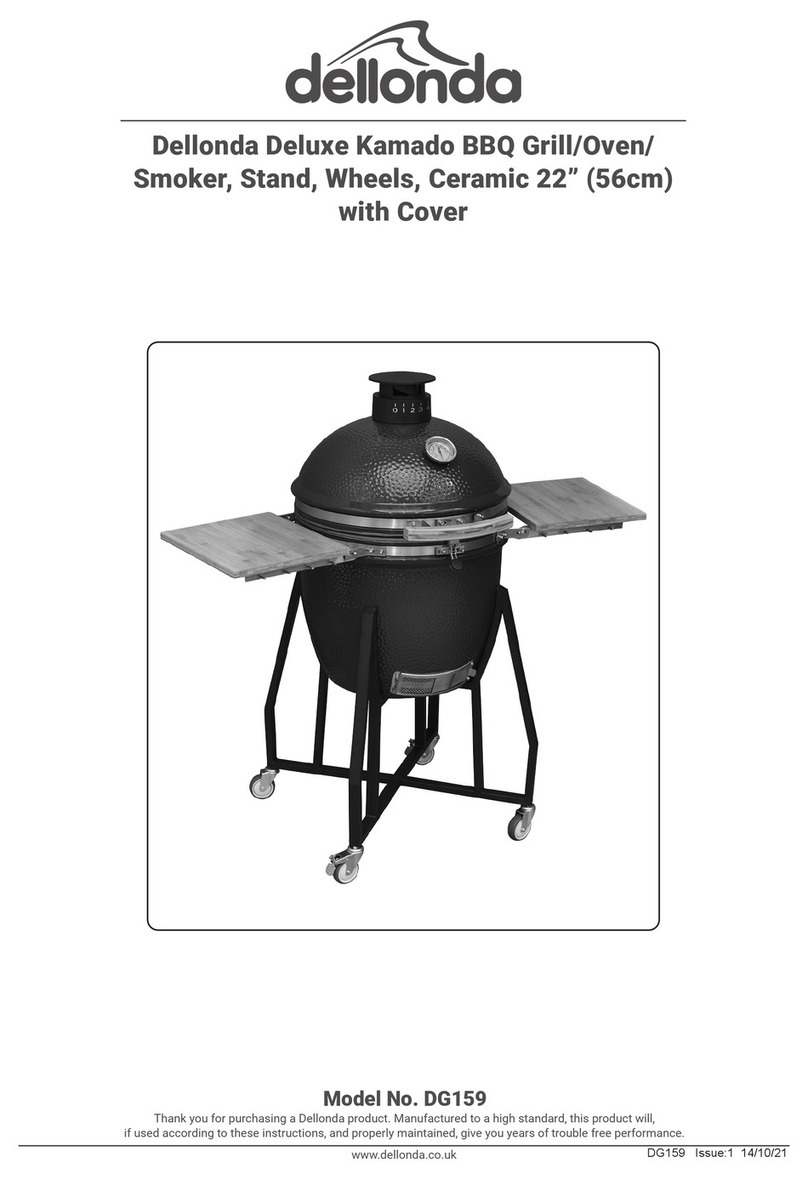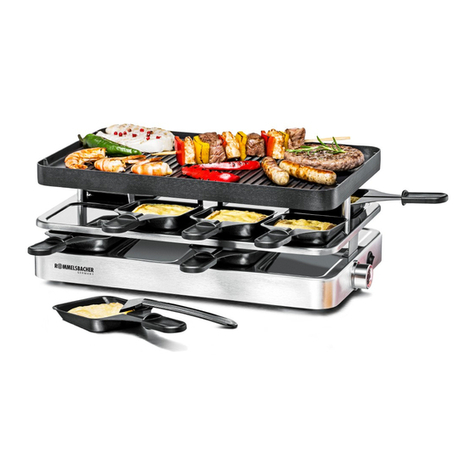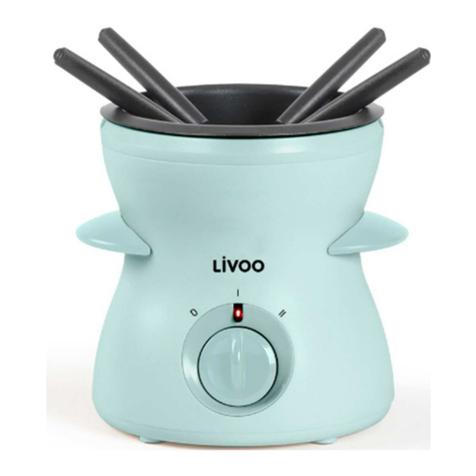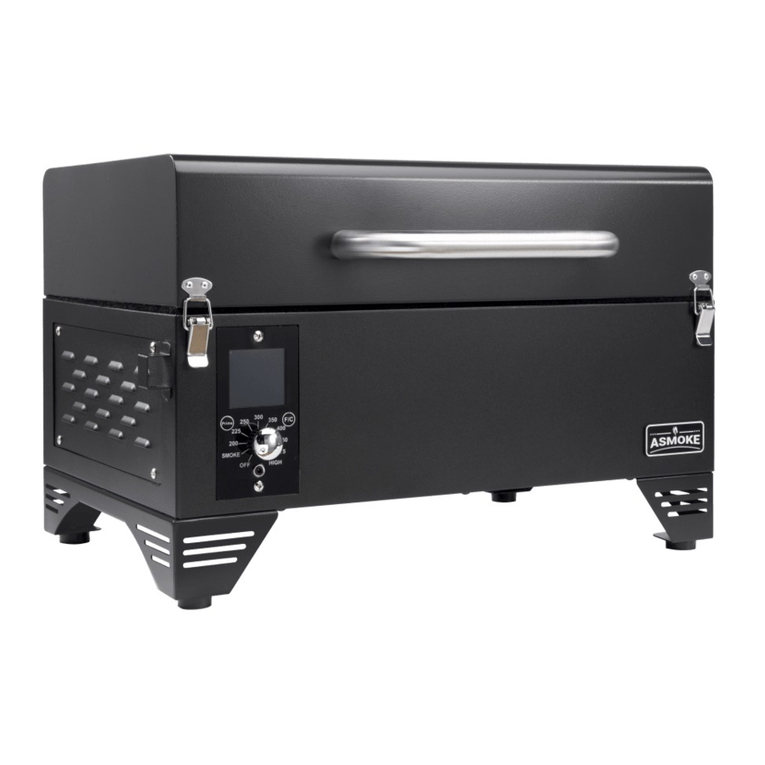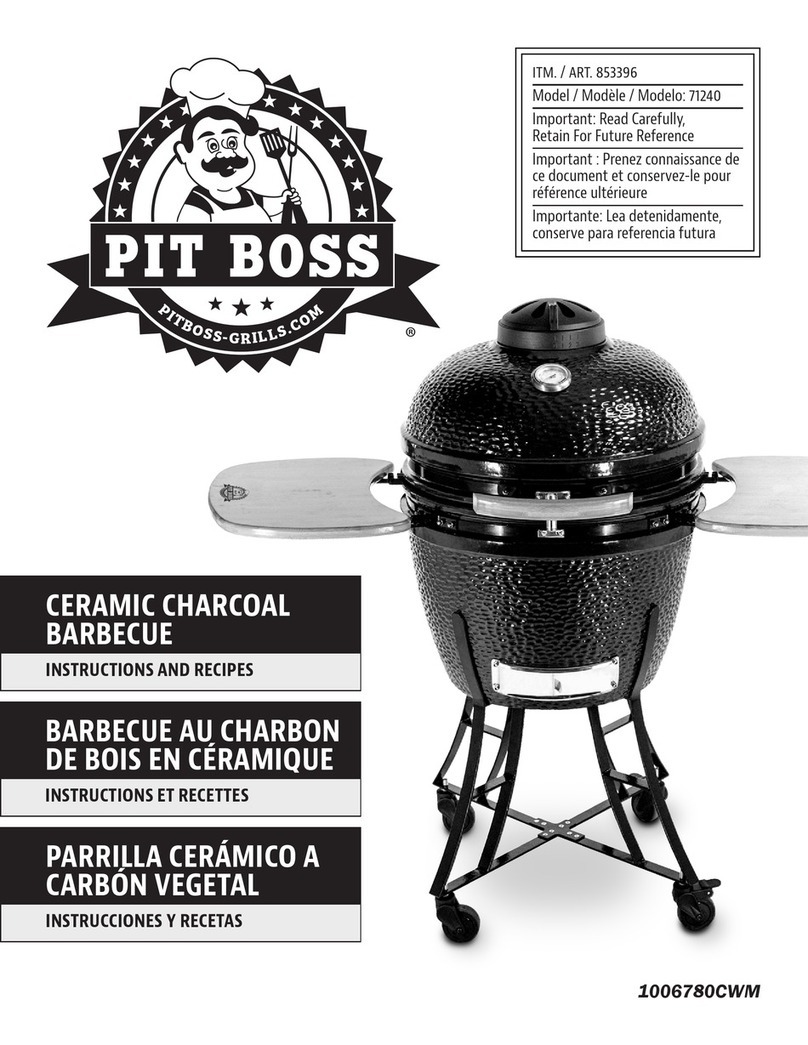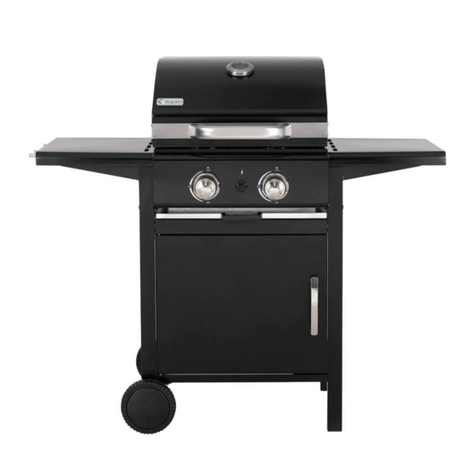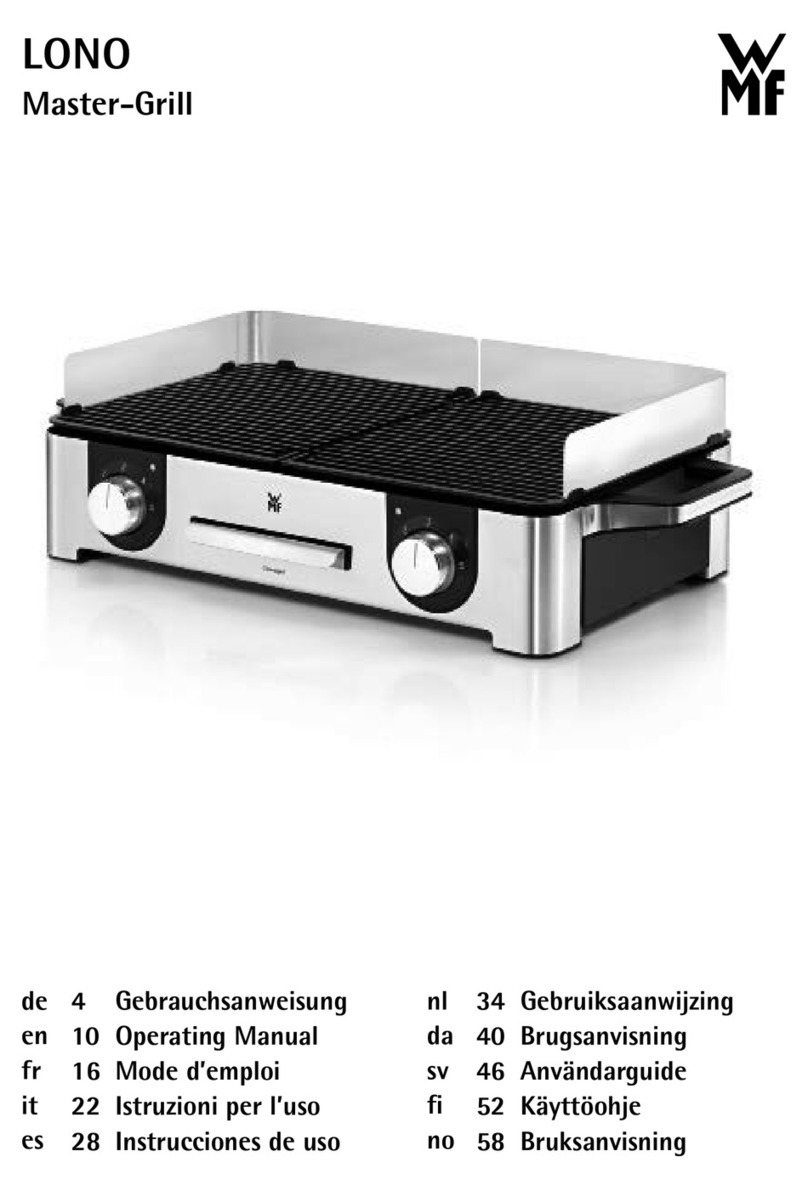Tucker R CLASS Series Assembly instructions

V20.02.20
ASSEMBLY, INSTALLATION
AND OPERATING INSTRUCTIONS
BUILT-IN BARBECUE
FOR R CLASS SERIES
MODELS:
1R, 2R, 3R, 4R, 5R, 6R.
1RS, 2RS, 3RS, 4RS, 5RS.
1RSS, 2RSS, 3RSS, 4RSS, 5RSS.
RSS, V6, V8, V1O, V12, V8+1, V10+1.
IMPORTANT – PLEASE READ ALL INSTRUCTIONS
BEFORE YOU ASSEMBLE, INSTALL OR
OPERATE THIS APPLIANCE.

1
IMPORTANT SAFETY INSTRUCTIONS
BARBECUE ASSEMBLY INSTRUCTIONS
INSTALLATION INSTRUCTIONS & WARNINGS
SPECIFICATIONS
DIMENSIONS
GAS INSTALLATION AND
LEAK TEST PROCEDURE
OPERATING INSTRUCTIONS
COOKING HINTS
TROUBLESHOOTING
SERVICE & MAINTENANCE
WARRANTY
2
3
5
7
8
10
12
14
15
16
17
CONTENTS

2
IMPORTANT SAFETY
INSTRUCTIONS
• Tucker R Class Barbecues are approved for
outdoor use only.
• Remove all plastic protection lm from stainless
steel components before assembly.
• Clean your barbecue regularly; check the
grease tray for excess grease build up, as
damage by grease or fat re is not covered by
warranty.
• Always turn off gas supply when you nish
barbecuing.
• A canvas cover for this barbecue will extend its
life and ensure trouble free operation.
• For installation of this barbecue onto a cabinet
trolley refer to relevant instructions.
• For installation of the this barbecue into an
insulation jacket refer to the instructions.
• Attend an operating barbecue at all times.
• Do not use indoors or in any enclosed area.
• Do not spray aerosols in the vicinity of this
appliance while it is in operation.
• Do not place articles on or against this
appliance.
WARNING FOR
YOUR SAFETY
If you smell gas:
1. Shut off gas supply to appliance.
2. Extinguish any open ame.
3. Open lid or hood.
4. If odor continues, immediately call your gas
supplier or your Fire Department.
• Failure to follow these instructions may cause
serious bodily injury or damage to property.
• Read all instructions carefully before assembly
and usage of barbecue.
• This barbecue must not be used indoors.
• Keep this manual for future reference.
• Do not store spare gas bottles, petrol, ammable
vapours or liquids in the vicinity of this barbecue.
• Do not use or store ammable liquids in or near
this appliance.
• Always leak test /check hose connections after
lling cylinders.
• Check cylinder condition for rust and that the date
stamp is current as every gas cylinder in Australia
must be pressure tested every ten years.
• Never disconnect the barbecue whilst it is running.
• Do not modify this appliance.
• Do not allow children to operate the barbecue.
• If a grease/fat re should arise, turn off the gas
supply immediately until extinguished.
• Always open the lid or hood before lighting.
HAZARDOUS FIRE OR EXPLOSION MAY RESULT
IF INSTRUCTIONS ARE IGNORED.
It is the consumer’s responsibility to see that the
barbecue is properly assembled, installed and taken
care of. Failure to follow instructions in this manual
could result in injury and /or property damage.

3
BARBECUE ASSEMBLY
INSTRUCTIONS
• Remove the pallet and any plastic lm protecting
or covering any parts of the Barbecue before
assembly.
• Cut away any packaging or cable ties that may
be holding components in place.
• Check you have all the correct components as
listed below.
10mm spanner
Phillips head screwdriver
TOOLS REQUIRED FOR ASSEMBLY
*Check that you have the correct gas type Barbecue i.e. L.P.GAS (red
sticker) NAT GAS (black sticker). The Gas Type Label is located on the right
hand side of the Barbecue Body.
BARBECUE PARTS
1x R Class Barbecue Body
1x Barbecue Fascia
1x
Grease Tray
x1 Control Valve
adjustment
Screwdriver
1x Grill 1x Plate
1x
Hose & Regulator
Flare Guard
Check Table Below
RSS V6 V8 V8+1 V10 V10+1 V12
A0122334
FLARE GUARDS QUANTITY FOR EACH BARBECUE MODEL

4
3. Place the Grill Flare Guards into the Barbecue,
they are designed to sit directly above the
burners below the open cooking grills.
There is a tag on each corner of the are
guard which locates them into the holes in the
barbecue front and rear panels.
1. The R Class BBQ can be installed into either an
Insulation Jacket or optional Cabinetry Trolley.
Please read relevant assembly installation
instructions before use.
2. Roasting hoods or at lids are also optional for the
R Class BBQ please read separate roasting hood
or at lid instructions prior to BBQ assembly and
installation.
BARBECUE ASSEMBLY
The Flare Guards are NOT required under the
cooking Hot Plate as they will inhibit the ame
from the burners heating the hot plate.
The R Class BBQ should look like this once you have
placed it into the assembled insulation jacket, for
built-in purpose. Place the stainless steel cooking grill above the are
guards and the stainless steel hot plate beside the
cooking grill.
Once you have assembled the barbecue
wipe it over to remove greasy ngerprints with
stainless steel polish and a soft cloth.
There is an optional angle support kit available
for the R Class if you wish to suspend it between
benchtops.

5
INSTALLATION INSTRUCTIONS
& WARNINGS
INSTALLATION INSTRUCTIONS INSTALLATION WARNINGS
READ THE IMPORTANT INFORMATION
ON THE FRONT OF THE BARBECUE
This barbecue is designed and approved for outdoor
use only.
Be mindful of the location of installation of the
barbecue.
When deciding on a location to install your
BBQ, we recommend that you install it with the
prevailing wind blowing into the front of the BBQ.
Strong winds blowing into the back or across the
back of the Roasting Hood can cause overheating
of the BBQ. The Roasting Hood is designed so that
Hot air is released through a vent in the back of the
Hood. When the Roasting Hood is shut strong winds
can prevent the hot air escaping out of this vent and
may even in some cases push the hot air down and
out the front of the BBQ which can cause damage
to the ignition system and control valves.
The intended use of this barbecue is to be installed
into cabinetry or brickwork. It may be placed onto a
bench or cut into an opening in a bench.
Be sensible about the location of your barbecue.
The barbecue must be located on a solid and level
surface that can safely support the BBQ.
Do not locate the barbecue near combustible
materials or surfaces, either above or around the
barbecue such as over hanging trees, bushes or
ammable liquids and the like.
Do not obstruct any of the air ventilation openings on
the front of the barbecue.
Do not use this appliance indoors or on marine craft.
This appliance shall only be used in an above
ground, open-air situation with natural ventilation,
without stagnant areas where gas leakage and
products of combustion are rapidly dispersed by
wind and natural convection.
Any enclosure in which the appliance is used shall
comply with one of the following:
• An enclosure with walls on all sided, but at least
one permanent opening at ground level and no
overhead cover. (gure 1)
• Within a partial enclosure that includes an
overhead enclosure and no more than two walls.
(gure 2)
• Within a partial enclosure that includes an
overhead cover and more than two walls, the
following shall apply. (gure 3,4 ,5)
• At least 25% of the total wall area is completely
open.
• At least 30% of the remaining wall area is open
and unrestricted.
• In the case of balconies, at least 20% of the total
of the side, back and front wall areas shall be
and remain open and unrestricted.
For alternative types of installations, contact your
nearest dealer.

6
DIAGRAMMATICAL REPRESENTATIONS
OF OUTDOOR AREAS
FIGURE F1 – OUTDOOR AREA – EXAMPLE 1
FIGURE 4 OUTDOOR AREA –EXAMPLE 4
FIGURE F2 – OUTDOOR AREA – EXAMPLE 2
FIGURE F5 – OUTDOOR AREA – EXAMPLE 5
FIGURE F3 – OUTDOOR AREA – EXAMPLE 3
The following gures are diagrammatical
representations of outdoor areas. The areas used in
the gures below are examples – the same principles
apply to any other shaped area.
Both ends open
Open side at least 25%
of total wall area
30% or more in total
of the remaining wall
area is open and
unrestricted.
OPEN AT SIDE AT LEAST 25% OF TOTAL WALL AREA. 30% OR
MORE IN TOTAL OF THE REMAINING WALL AREA IS OPEN
AND UNRESTRICTED.
OPEN SIDE AT LEAST 25% OF TOTAL WALL AREA. 30% OR
MORE IN TOTAL OF THE REMAINING WALL AREA IS OPEN
AND UNRESTRICTED.
Open side at least 25%
of total wall area
30% or more in total
of the remaining wall
area is open and
unrestricted.

7
BARBECUE GAS CONSUMPTION TUCKER R CLASS BARBECUES ARE MADE AND
APPROVED TO AUSTRALIAN STANDARDS
A.G.A. APPROVAL NO. AGA 8351-G
SPECIFICATIONS
(In Mega Joules Per Hour)
No. of Burners. Natural Gas LPG:
1 Burner 15mj 17mj
2 Burner 30mj 34mj
3 Burner 45mj 51mj
4 Burner 60mj 68mj
5 Burner 75mj 85mj
6 Burner 90mj 102mj
Natural Gas injector size 1.8mm Pressure 1KPA
Propane Gas injector size 1.1 mm Pressure 2.75 KPA
WOK TYPE Natural Gas LPG:
Integrated S Wok 12.5mj 15mj
Natural Gas injector size 1.8mm Pressure 1KPA
Propane Gas injector size 1.1 mm Pressure 2.75 KPA
WOK TYPE Natural Gas LPG:
Integrated SS Wok 17mj 18mj
Natural Gas injector size 1.9mm Pressure 1KPA
Propane Gas injector size 1.1 mm Pressure 2.75 KPA
For LP Gas connections, an approved 2.75 KPA
regulator and hose assembly connection to the
appliance is tted by the manufacturer.
The appliance inlet is 3/8 S.A.E. male and is located
on the bottom right hand side of the barbecue at
the front.
For use with Natural Gas a 13mm ID Hose must be
used.
The minimum capacity propane cylinder for this
barbecue is 4 KG.
Warning in freezing conditions the pressure
of Propane gas can be reduced in the
Cylinder Tank causing a lack of gas
pressure, this may affect the way the
barbecue operates.

8
R CLASS BBQ DIMENSIONS
(Measurements in mm)
DIMENSIONS
Model V6 (3R) V8 (4R) V10 (5R) V12 (6R) V8+1 (4RSS) V10+1 (5RSS)
A695 855 1015 1435 1275 1435
B760 920 1080 1500 1340 1500
B
A
565mm
285mm
280mm
560mm
840mm
600mm80mm
The manifold is factory tted at the front on the base on the right-hand side. Manifold diameter is 20mm
square tube. The back is ush with the back of the BBQ when open. The at lid is 35mm high shut
and 580mm high when open.

9
CLEARANCES TO COMBUSTIBLES ARE AS
FOLLOWS
Minimum Top Clearance Allow 800mm
Minimum Side Clearance Zero
Minimum Rear Clearance Zero
C D E
345mm 455mm 145mm
C D E
465mm 650mm 280mm
V6 (3R) V8 (4R) V10 (5R) V12 (6R) V8+1 (4RSS) V10+1 (5RSS)
F765mm 925mm 1085mm 1505mm 1345mm 1505mm
F
680mm
280mm
D
C
E
The wall surfaces above the BBQ cooking
surface at the rear and on either side of the BBQ
must be made from non-combustible material,
if the walls are combustible then the BBQ must
have a clearance of 100mm at the rear and
100mm clearance on either side of
the BBQ.
R CLASS BBQ
RSS WOK (In BBQ Body)RSB WOK

10
CONNECTION OF A GAS CYLINDER TO
THE BARBECUE IS AS FOLLOWS
GAS INSTALLATION AND
LEAK TEST PROCEDURE
The hose assembly connection to the appliance is
tted by the manufacturer.
• Attach the regulator to the gas cylinder by
tightening the wing nut on the regulator rmly by
hand.
• Once connected, leak test the connections by
brushing a solution of soapy water around the
joints and gas cylinder valve.
Photo of what a typical leak looks like.
If bubbles appear around the connections,
you have a leak.
Turn off the gas supply and tighten or re-seal
the connection.
Leak test the connections again
Photo of what a good connection looks like
i.e. no bubbles.
If leaks are still present do not use the barbecue,
contact the place of purchase or your local dealer.
Apart from the connection point the hose must not
be touching any part of the barbecue where it may
get hot and be damaged.
For storage, cylinder exchange or relling,
disconnect the hose at the cylinder only.
Check that the hose is not kinked, squashed or under
tension.
Do not disconnect the hose from the appliance.
Do not attempt to open or adjust the regulator, if
you think it is not working properly consult your local
dealer.
There must be no naked ames in the area
when connecting the barbecue to a gas
supply.
You must have the control knobs in the off
position and have the gas supply on at the
cylinder valve.
Check for leaks after each gas rell.

11
FOR PERMANENT CONNECTIONS to natural gas or
a xed propane supply, an authorised person, in
accordance with these instructions, local gas tting
regulations, municipal building codes, the AGA
installation code AS5601 and any other relevant
statutory regulations, must be employed. Note the
installer must test the BBQ when the installation
is completed before leaving to make sure the
appliance operates correctly and is safe for the
operator to use.
The gas inlet connection must have a thread in
accordance with AS. 150 7.1 or AS. 1722.2
For connection to a natural gas bayonet tting,
a gas regulator must be tted at the inlet of the
appliance, and an approved 13mm, class A, natural
gas hose (no longer than 2 metres), going from the
gas regulator to the bayonet point, complying with
AS1869 must be used.
Where a mobile appliance is to be connected to
a xed gas supply via a exible hose connection
the restraining cord supplied must be xed to the
appliance and the wall/oor within 50mm of each
connection point. The length of the restraining cord
shall not exceed 80% of the length of the hose as it
is designed to prevent stress on the hose assembly
when the appliance is moved out of its normal
operating position.
It is recommended that an isolation valve and union
be tted before the barbecue; refer AS5601/ AG601
for correct pipe sizing to ensure adequate gas is
supplied to the appliance.
For natural gas check the pressure of the regulator,
and adjust if necessary to the pressure shown on the
data plate.
CONVERSION PROCEDURE FOR
AUTHORIZED INSTALLER
PROPANE GAS TO NATURAL GAS CONVERSION.
• Disconnect and disassemble / remove plate, grills,
are guards and burners from the barbecue.
• Remove the main injectors and replace them with
the correct 1.8mm injectors for each main burner.
If a Wok burner is tted replace the Wok injector
with the correct size required for Natural Gas
written on the data plate.
• Re-assemble burners, are guards, plate and grills.
• Replace the PROPANE GAS hose and regulator
with an approved Natural Gas Regulator and
Hose.
• Turn the gas on and test for leaks, repair if
necessary.
• Light 3 burners and turn them to high and set the
pressure at 1 KPA.
• Now turn the burners to the “LOW” setting and
check the ame pattern is steady, if necessary
you can adjust the low setting by removing the
gas control knobs and insert the 2.4mm slotted
screw driver supplied into the valve shaft, the
“low” setting can be adjusted up or down to suit
your gas pressure by turning the screw driver.
• Turn the screw driver anti-clockwise to adjust the
ame height up or turn it clockwise to turn it down.
• Check the operation of the ignition to the burners
and make any necessary adjustment.
• Ensure the data plate is changed / altered to
contain the correct information i.e. remove the
old Gas type label and replace it with a Natural
Gas label and the date of conversion.
GAS INSTALLATION
You want to achieve the lowest ame height at
“LOW” but you don’t want to adjust it too low as
it could blow out on its own or due to a breeze.
Low/simmer settings can not be adjusted on
BBQs with ame failure valves.

12
OPERATING INSTRUCTIONS
BARBECUE OPERATING INSTRUCTIONS
MANUAL LIGHTING INSTRUCTIONS.
1. Remove the lid or open the hood before lighting
the BBQ.
2. Turn all the gas controls to the OFF position.
(clockwise).
3. Turn on the gas supply at cylinder valve or
supply.
4. Push and turn (Anti-clockwise) the control knob
you wish to light to the high position.
5. Wait for 3 seconds.
6. Push the ignition button next to the control knob 2
or 3 times to ignite the burner.
7. If the burner does not light turn the control knob to
off, wait 1 minute and retry.
To turn the barbecue off, simply turn the control
knobs to the OFF position, and then turn off the gas
supply at the cylinder or supply.
To light the BBQ manually place a match into the
manual lighting Match Holder.
1. Turn on one control knob under the grill section of
the BBQ to High and light the match in the Match
Holder.
2. Push the Match Holder through the gap in the
grill in line with the control knob you have turned
on and just below the side of the Flare Guard. If
the BBQ does not light within 5 seconds turn the
control knob to off, remove the grease tray to
allow built up gas to disperse, wait 1 minute and
try it again.
If the barbecue burners should not light after 10
seconds or are blown out due to strong winds,
care should be taken.
Remove the barbecue drip tray and wait 1
minute before re-lighting to let any gas disperse.
Do not force the control knobs, they will turn
easily, depress the knobs and turn them
anti-clockwise.
The gas controls can be adjusted from high to
low.
1. The burners can cross light off each other.
2. Once one burner is alight, turn the burner
next to it onto the High position.
3. The ame will jump across to that burner.
4. If it does not light within 10 seconds turn the
burner off and wait 1 minute and repeat the
procedure.
5. Light one burner at a time in this manner.

13
LIGHTING INSTRUCTIONS FOR BBQS WITH
FLAME FAILURE VALVES FITTED.
LIGHTING THE APPLIANCE
1. Remove the lid or open the hood before lighting
the BBQ.
2. Turn all the gas control knobs to the off position.
3. Depress the control knob you wish to light and turn
it anti-clockwise to the High setting position whilst
continuing to keep the control knob depressed.
4. Push the ignition button next to the control knob 2
or 3 times to ignite the burner.
6. If the burner does not light, turn the control knob
to the off position and wait 1 minute for any
accumulated gas to dissipate.
7. To turn the appliance off, depress the control
knob and turn it clockwise to the off position
then turn off the gas supply at the cylinder or gas
supply.
You must continue to keep the control knob
depressed even after the burner is alight for a
further 30 seconds to activate the safety ame
failure switch inside the control valve.
BBQs with ame failure valves tted to them are
not made with a low setting adjustment screw.
In the event the gas safety switch tted to the
appliance turns the gas supply off due to high
wind blowing out the ame or in the event that
the appliance has been tilted, wait 1 minute
before trying to relight the appliance following
the lighting procedure above.
You may also light the burner manually with the
Match Holder but you must still keep the control
knob depressed for 30 seconds to activate the
safety switch inside the control valve.
NEW BBQ ‘BURNING IN’ PROCESS
PRE-HEATING THE BBQ BEFORE COOKING
Open the Roasting Hood for this process.
1. Brush a very light coating of cooking oil over the
surface of the Cooking Grills and Solid Hot Plate.
2. Turn all Burners onto low and run the BBQ for
5 minutes than turn it off.
3. When its cool rub the entire surface of the Plate
and Grills again with a light coating of oil.
4. This will protect them from surface rust as moisture
in the air can cause surface rusting.
5. Close the Roasting Hood when you have nished
oiling.
1. Brush a very light coating of cooking oil over the
plate or grill prior to lighting.
2. Preheat the BBQ on high for 2-3 minutes.
3. We recommend you cook on the Medium setting
as you will have sufcient heat to Grill or Roast.
4. If more heat is required, you can turn it up a little
if need be.
5. Flare up will occur if the cooking surface gets too
hot.
6. The recommended cooking temperature inside
the Roasting Hood is 180OC, never exceed 200OC
with the Roasting Hood closed.
If you notice smoke rising up off the surface of
the BBQ, turn the burners to low or the oil will
start to burn and if left on high for much longer
the oil could catch on re if it reaches its ignition
point of approx 300oC+

14
COOKING HINTS
Flare ups will occur if the cooking surface gets too
hot, the recommended cooking temperature is
180oc with a Roasting Hood closed.
If are ups occur turn the BBQ down and the are will
subside as the temperature will decrease.
Always turn the meat with tongs, a fork will pierce the
sealed surface and let out the juices.
A few green gum leaves placed onto the cooking
grill or hot plate will give an Aussie bush avour to
your meat or vegetables.
Don’t slash the steaks to see if they are cooked, press
the steak on the top if its soft it is rare, if it is slightly
springy it’s medium rare, less springy medium and
when rm its well done.
If time permits marinade the meat for added avour
and tenderness. A basic wine, herb, onion and garlic
marinade is ne.
Fruit and vegetable accompaniments can be
cooked alongside meat or grilled in a Wok on the
Wok burner. Some are best wrapped in foil to retain
juices or you can place them on skewers.
Go easy on sugar and honey in marinades and
basting sauces as very sweet mixtures tend to scorch
easily.
Grilling the perfect steak requires the grill to be
pre-heated well so that the grill is hot, this whey when
you place your steak on the grill it will sear the meat
quickly on the outside of the steak, it is best to turn
the steaks over often, say every 20-30 seconds as this
will ensure the meats fat and enzymes are evenly
cooked, you may like to cook your steaks until the
blood shows through them before you turn them
but you will not be able to cook rare or medium rare
steaks this way as they will start to overcook in this
manner.
Place sausages on the grill or plate and turn them
frequently to brown the surface evenly. Be careful
not to use to much heat as sausages contain a lot of
fatty oil which will cause the ame to are up burning
the outside of the sausage when cooked over the
open grill.
Bacon, eggs, mushrooms, tomatoes and onions are
best cooked on the plate you can toast buns or
bread on the open grill.
Fish, can be cooked on the plate with our and
herbs or wrapped in foil to seal in the juices on the
grill.
Cooking times for sh vary as to the type and
thickness of them generally times are a lot shorter
than meat.
1. Check the grease collection tray after each use
and wash it in hot soapy water in the sink.
2. Scrape the plate and grills clean and wipe them
over with a coat of cooking oil.
3. Wipe the barbecue over with a soft cloth to
remove grease and marks.
4. Replace the lid or close the hood to protect the
cooking surfaces from the weather when storing
the BBQ away.
5. Check the gas supply is turned off.
6. Cover the barbecue with a Tucker barbecue
cover (optional extra recommended) when the
barbecue is cooled down.
COOKING TIPS CLEAN UP

15
TROUBLESHOOTING
• Barbecue won’t light? Check all gas connections
and that the gas bottle has gas.
• Ignition is not working? Check the leads are
connected properly and adjust the spark gap to
make sure the gap is 4mm from the ports on the
burner.
For Natural Gas it is best to have the igniter probe
just above the ports on the burners and for L.P.
Gas it is best positioned just below the ports on
the burners.
• One of the burners won’t light? Check the
throat of the burner for blockages, remove the
air mixture cap and gauze on the throat of the
burner, check the control valve injector, it may
be blocked.
• Control knobs are stiff? Remove knobs and oil
the shafts of control valves where the brass shaft
enters the alloy housing.
• Barbecue doesn’t seem to be as hot anymore?
Check inlet and burner port holes for blockage or
regulator pressure. Insects maybe in the burners.
TROUBLESHOOTING SOLUTIONS

16
SERVICE & MAINTENANCE
1. Before each use remove any accumulated
grease and other cooking residue. Fat/grease res
are not covered by warranty.
2. Your barbecue should be cleaned regularly with
hot soapy water and dried afterwards. Do not
use steel wool as it will leave steel deposits on the
surface of which can cause rust. Scotch Bright
pads can be used but will generally leave scratch
marks where you have rubbed. Only use these on
stubborn un-washable deposits..
3. To remove rust marks, we recommend Eagle One
NEVER DULL wadding polish. To prevent rust marks,
polish the barbecue with stainless steel polish
regularly.
Hint, rub the BBQ over with a cloth after each
use when the BBQ is still hot and the grease on
the BBQ will wipe off easy and make it easy to
look after as it leaves a slight cover of grease on
the stainless steel which impedes the salt air from
settling in the pours of the stainless steel surface.
4. Grease or oil the shafts of the gas control valves
where they enter the alloy housing every 3 months
to avoid them ceasing up. If they become hard to
turn or if you smell gas, get the BBQ serviced.
5. Periodically check the leads on the ignitions
for cracks or the connections to the probes or
buttons.
6. Do not attempt to dismantle control valves or the
regulator.
7. Periodically remove the burners and scrub them
with soapy water and a wire brush. Make sure
the ports are clear from obstructions, unscrew
the air mixture cap and gauze from the throat of
the burner periodically and brush away any dust,
spiders webs or insect nests that may have built
up, replace them and screw them back on.
When replaced turn each burner on and check
that the ame pattern is good, you can adjust the
air mixture by turning the cap on the end of the
burner throat open or closed. You want a blue
ame with a yellow tip.
8. Check the hose and regulator regularly and
replace if damaged.
9. It is recommended that the hose and regulator
be replaced every 5 years.
FOR SERVICE OR REPLACEMENT PARTS,
CONTACT YOUR NEAREST DEALER OR
TUCKER AUSTRALIA PTY LTD.
10. If you cannot operate the barbecue correctly
turn it off. Do not continue to use it. Take it back
to the place of purchase or local dealer and get
them to test and
repair it.
11. Stainless Steel barbecues can be affected
by high temperatures of which can cause
discoloration on the BBQ frame.
12. Check and tighten nuts and bolts on the
barbecue regularly.
13. A canvas cover will help keep your barbecue
protected from weather.
Make sure the barbecue is dry before putting
the cover on or corrosion may occur. Coastal
climates are particularly vulnerable to this.
14. Check all connections for gas soundness.
Servicing must only be carried out by
authorized personnel.
This appliance must not be modied.
Check gas cylinder regularly for test date
status.
We recommend service of this appliance to
be done by an authorized person every two
year.
TAKE CARE OF THE APPLIANCE

17
WARRANTY
TUCKER R CLASS BARBECUE
WARRANTY PERIOD
NOT COVERED
CONDITIONS OF THIS WARRANTY
Stainless steel body
Gas manifold
Stainless steel burners
Cross lighting panel
Gas control valves
Flare Guards
Grease collection tray
Ignitions
All other parts
10 years
Lifetime
2 years
2 years
1 year
2 years
5 years
1 year
1 year
The warranty does not cover the purchaser or any
other person for damage malfunction or loss due to
the following:
• Lack of maintenance, abuse, neglect, misuse,
accident, or improper installation of this
appliance.
• Scratches, dents or discoloration caused by heat,
abrasive or chemical cleaners.
• Damage due to grease or fat res.
• Failure of burners and valves due to insect
blockage.
• Distortion of vaporisers.
• Surface rust.
• Cleaning and normal wear and tear.
• Unauthorized repairs during the warranty period.
• Removal or re-installation costs.
SERVICE CALLS OF THE ABOVE NATURE ARE
CHARGEABLE
1. The appliance is delivered to TUCKER AUSTRALIA
distributors service department or authorized
service agent and freight charges both ways is to
be paid by the owner. No liability is accepted for
loss or damage during transit.
2. The appliance is installed by a qualied person
and operated and maintained in accordance
with the instructions supplied. Repairs and service
must be carried out by an authorized person.
3. Installation must conform to the standards laid
down by the local codes or, in the absence
of local codes, with AGA code AG:601
AS:5601:2002
4. No alterations or repairs are to be carried out
without obtaining the distributors prior consent.
Such repair or any replacement does not extend
the warranty period.
5. Proof of purchase together with this warranty
must be provided to verify purchase date and
establish the warranty period. Only the original
purchaser is covered under this warranty.
6. Where this warranty is inconsistent with any state
laws, the rights of the purchaser shall prevail.
7. Parts installed from other manufacturer’s
products will nullify this warranty.
WARRANTY PERIOD
FOR YOUR RECORDS
Model:
Serial Number:
Retailer:
Purchase Date:
Gas type:
TUCKER AUSTRALIA PTY LTD.
138 Silverwater Road
Silverwater NSW 2128 AUSTRALIA.
PHONE: (+612) 9748 8368
FAX: (+612) 9748 8138
WEB SITE: www.tuckerbbq.com.au
EMAIL: [email protected]

18
NOTES

TUCKER AUSTRALIA PTY LTD.
138 Silverwater Road
Silverwater NSW 2128 AUSTRALIA.
PHONE: (+612) 9748 8368
FAX: (+612) 9748 8138
WEB SITE: www.tuckerbbq.com.au
EMAIL: [email protected]
Other manuals for R CLASS Series
1
This manual suits for next models
23
Table of contents
Other Tucker Grill manuals

